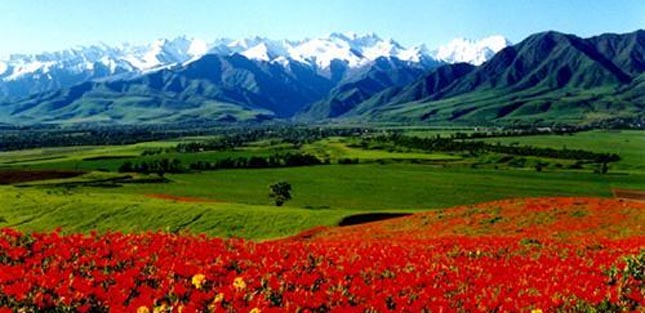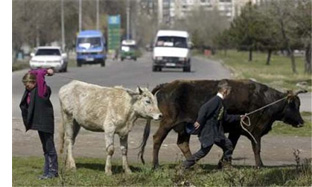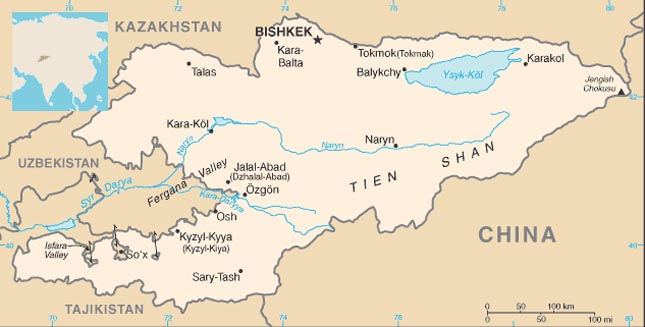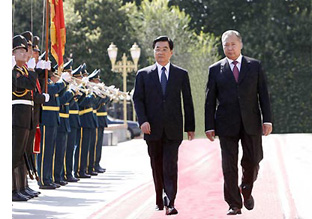China Invests in Kyrgyzstan for Central Asia Leadership

This is the eighth in a series of articles that looks at China’s borders. As China has grown in the last 30 years, so have the often complicated relationships it has with its many varied neighbors. In this article, we take a look at Kyrgyzstan.
By Joyce Roque
April 25 – The Kyrgyz Republic remains to be a country in the process of unraveling itself. It is the second smallest country of the five central Asian states bordered by Kazakhstan to the north, Uzbekistan to the west, Tajikistan to the southwest and China to the east. Despite being a land blessed by breathtaking natural beauty – some calling its Tien Shan range the Switzerland of Central Asia – it is one of the poorest in the world with an estimated 40 percent of its population living below the poverty line.
The Tulip Revolution
In 1991, the country declared independence from former Soviet Union led by Askar Akayev. The divorce from Kremlin would lead to devastating effects on its economy when an estimated 98 percent of its exports depended on the Soviet market. It hindered the country’s goal of transitioning to a free market economy. Akayev would later on be ousted in popular revolt in 2005 called the Tulip Revolution on accusations that government interfered with parliamentary elections aggravated by the country’s widespread poverty and corruption.
 He would be replaced by Russian-educated Kurmanbek Bakiyev, who would win by a landslide during the presidential election of July 2005. Three years since, the country is still saddled by a volatile political and economic market that tends to scare foreign investment. Issues like privatization of state-owned enterprises, expansion of democracy and political freedoms, inter-ethnic relations, and terrorism remain unresolved. Bakiyev has proved his mettle as a political survivor; weathering constant storms that threatened to put him out of power just like his predecessor.
He would be replaced by Russian-educated Kurmanbek Bakiyev, who would win by a landslide during the presidential election of July 2005. Three years since, the country is still saddled by a volatile political and economic market that tends to scare foreign investment. Issues like privatization of state-owned enterprises, expansion of democracy and political freedoms, inter-ethnic relations, and terrorism remain unresolved. Bakiyev has proved his mettle as a political survivor; weathering constant storms that threatened to put him out of power just like his predecessor.
In search of gold
Kyrgyztan’s two major cash cows are gold and agriculture, with gold as its number one export capable of dictating fluctuations in GDP. The country also has substantial deposits of coal, gold, uranium, antimony, and other rare-earth metals. Outside the gold mining industry, its formal sector is still ill-equipped. A snapshot of domestic commerce will show that majority of trade is unregulated in small village kiosks and bazaars. In 2007, economic growth reached 7.5 percent on the strength of construction, services and the high prices of gold.

The Kumtor Gold Mine alone boasts of the largest gold reserves in the world although it is slated to be closed by 2010. Other gold mines are in the works to replace the void: Jerooy, Taldy–Bulak, and Tokhtonysay. All the gold mines are owned by the state agency Kyrgyzaltyn in joint venture with foreign companies. The government has been aggressive in attracting foreign involvement for ventures that extract and process gold.
Recently, Henan-based gold mining company, Lingbao Gold, announced that its 99 percent-owned Kyrgyzstan subsidiary Full Gold Mining would purchase the prospecting rights of the Istanbul Gold Mine in Kyrgyzstan from China Road & Bridge Corporation for US$25.3 million. The move will increase Lingbao Gold reserves by 20 percent. The gold mine is said to have reserves worth 23.48 tons.
Since the days of the legendary Silk Road, China and Kyrgyzstan have actively engaged in trade. The Kyrgyz Republic is China’s second largest trading partner in Central Asia. Bilateral trade in 2006 amounted to a total of US$2.26 billion last year, up by 128.6 percent. By January 2008, bilateral trade reached US$459 million, an increase of 226.6 percent compared to last year’s figures.
Partnerships
 Kyrgyzstan shares company with China through its membership in the six-nation mutual-security organization, the Shanghai Cooperation Organization (SCO) that also includes Russia, Kazakhstan, Tajikistan and Uzbekistan.
Kyrgyzstan shares company with China through its membership in the six-nation mutual-security organization, the Shanghai Cooperation Organization (SCO) that also includes Russia, Kazakhstan, Tajikistan and Uzbekistan.
Under the tenets of the SCO, Kyrgyzstan and China have held military exchanges over the years. Last year, the two reiterated their commitment to fight against the terrorist group – the East Turkistan Islamic Movement (ETIM) – as a vital part of the struggle against terrorism, separatism and extremism in the region. The ETIM is a minority Uygur separatist group that has been accused by Beijing as working towards dividing the nation through attacks at its western Xinjiang-Uygur Autonomous Region. In addition, they also agreed on improving cooperation to combat cross-border crimes and other non-traditional security threats.
Another factor that will enhance bilateral relations is the completion of the highway corridor that will connect China, Kyrgyzstan, and Uzbekistan by the end of 2008. It is set to be the modern version of the Silk Road that will effectively link China with the rest of Central Asia.
Ju Kuilin, deputy-director of the International Department of the Ministry of Finance, told Xinhua that the highway’s China section has already been finished while construction on other sections outside China has been on the way.
The corridor is being done under the framework of Central Asia Regional Economic Cooperation (CAREC), which has garnered support from agencies such as the Asian Development Bank (ADB).
So far, the Chinese government has spent RMB60 million (US$7.5 million) in the Kyrgyzstan section of the highway.
The 937 kilometer highway will begin in Northwest China’s Xinjiang Uygur Autonomous Region, till Kyrgyzstan ending at Tashkent, Uzbekistan. CAREC member countries that include Afghanistan, Azerbaijan, Kazakhstan, Kyrgyzstan, Mongolia, Tajikistan, Uzbekistan and China are envisioning a regional transport network that will mimic the ancient silk road route of yore.
Playing the geopolitical game
China and Kyrgyzstan have maintained diplomatic relations in the past 15 years. The Sino-Kyrgyz Friendly Treaty on Good-Neighborly Cooperation signed in 2002 further developed economic relations. The latest treaty between the two was approved on Aug 2007, which called for improving bilateral relations, anti-terrorism, military cooperation, trade promotion and other issues of common concern. The treaty also placed particular emphasis on national sovereignty and territorial integrity. China has the issue of Taiwan to contend with while Kyrgyzstan has pending boundary delimitation disputes with Kazakhstan, Tajikistan and Uzbekistan.
More than the issue of trade, Kyrgyzstan relations seem to be at the bedrock of China’s Central Asia diplomatic strategy. China is stockpiling Kyrgyz goodwill. Kyrgyzstan serves the geopolitical purpose of being at the center of the Central Asian region. Whoever exerts the most influence on the country will already have gained a gateway for intelligence activities and military operations in sensitive areas like Afghanistan, Pakistan, China and even Russia. During the Soviet era alone, around 50 airports and airstrips were built in the country as a military precaution.
The significance of the region has been increasing. Just as the work of Sir Halford Mackinder proposed in the early twentieth century that the Eurasian heartland had great significance in world affairs; the region has the potential to become a major economic and cultural opportunity that could be a source of influence beyond Europe.
Already, Kyrgyzstan plays host to foreign military bases: the Russians at Kant airbase and the Americans at Manas airport. The two military superpowers are a mere 30 km (19 miles) apart from each other. If the cards are dealt right, Central Asia could become an integration zone for security and economic affairs that will re-conceptualize world regions with China at its helm.
This is the eighth in a continuing series that focuses on China’s borders. The complete series to date can be found here.
- Previous Article Spring issues of Vietnam Briefing, India Briefing out now
- Next Article Why Chinese managers make better economic sense than expatriate ones




























